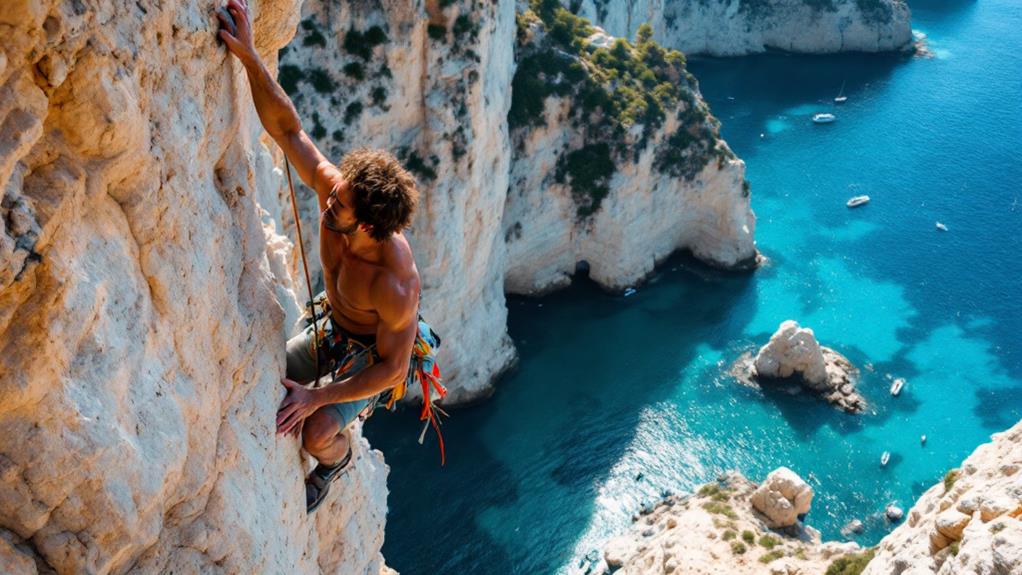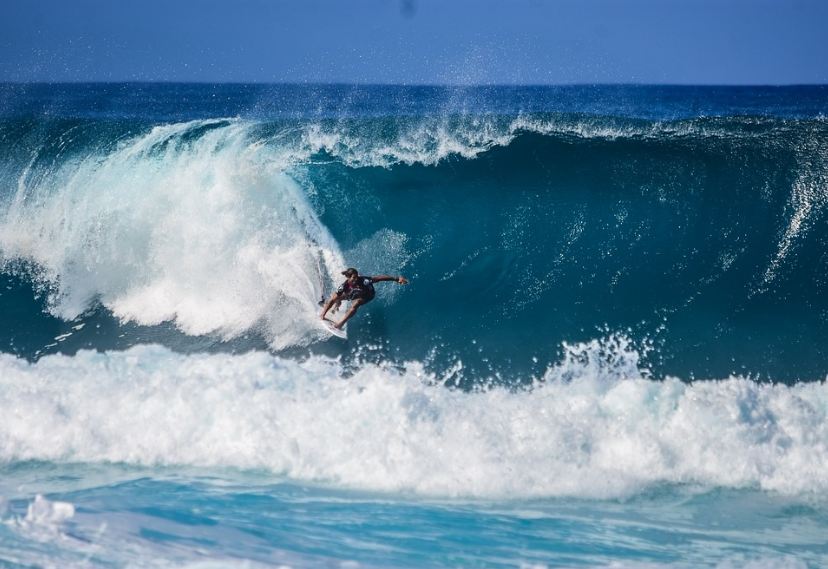What Is Deep Water Soloing?

Deep water soloing is an extreme form of rock climbing where you scale cliffs or rock formations above deep water without ropes or harnesses. Originating in Mallorca, Spain in the 1970s, it combines the challenge of traditional climbing with the thrill of a potential plunge into the water below. You'll need minimal gear - just climbing shoes, chalk, and a strong swimming ability. Safety is paramount, as you'll be falling from heights into open water. It's crucial to assess water depth, rock quality, and weather conditions before attempting any climb. The unique blend of climbing and aquatic adventure makes deep water soloing an increasingly popular pursuit for thrill-seekers worldwide.
Origins of Deep Water Soloing
The sun-drenched cliffs of Mallorca, Spain, witnessed the birth of deep water soloing in the late 1970s. This daring form of rock climbing emerged when local climbers sought new challenges along the island's coastal cliffs. They discovered that the deep Mediterranean waters below provided a natural safety net, allowing them to climb without ropes or harnesses. Early extreme sports like Hawaiian sled rides and bungee jumping laid the groundwork for the development of deep water soloing.
Psicobloc, as it's known in Spanish, quickly gained popularity among the climbing community. You'll find that the sport's pioneers, like Miquel Riera, played a crucial role in developing and promoting this unique style of climbing. They pushed the boundaries of what was possible, tackling increasingly difficult routes and higher climbs.
As word spread, deep water soloing attracted climbers from around the world to Mallorca's shores. You'll see that the sport's appeal lies in its simplicity and the pure, unencumbered connection between climber and rock. It's a test of both physical and mental strength, as you climb knowing that a fall means plunging into the water below.
Today, deep water soloing has expanded beyond Mallorca, with enthusiasts seeking out suitable locations worldwide.
Essential Equipment and Gear
While deep water soloing's origins emphasize its minimalist nature, you'll still need some key items to ensure safety and performance. Your most crucial piece of equipment is a well-fitting pair of climbing shoes. Choose shoes that provide excellent grip and comfort, as you'll be wearing them in and out of the water. Beginners are recommended to pack multiple gears to ensure they have the necessary equipment.
A chalk bag is essential for keeping your hands dry and improving your grip on the rock. Opt for a water-resistant chalk bag to prevent your chalk from getting wet. You'll also want to bring a towel to dry off between climbs and a waterproof bag to store your belongings.
Safety gear is paramount. A properly fitting personal flotation device (PFD) is a must-have, especially in areas with strong currents or deep water. Consider wearing a helmet to protect against head injuries from falling rocks or accidental impacts with the cliff face.
Don't forget sun protection. Apply waterproof sunscreen and wear quick-drying, UV-resistant clothing. Sunglasses with a secure strap will shield your eyes from glare off the water. Lastly, bring plenty of water and snacks to stay hydrated and energized throughout your climbing session.
Choosing the Perfect Location

Selecting an ideal spot for deep water soloing is crucial for both safety and enjoyment. You'll want to find a coastal area with overhanging cliffs or rock formations that drop directly into deep water. Look for locations with a minimum water depth of 15-20 feet to ensure a safe landing if you fall.
Research the area's tides and currents before you go. You don't want to be caught off guard by changing water levels or strong currents that could pull you away from your climbing spot. Check the rock quality too; avoid areas with loose or crumbly rock that could break off during your climb.
Consider the difficulty of the routes available. As a beginner, you'll want to start with easier climbs and gradually work your way up to more challenging ones. Look for a variety of routes to keep things interesting.
Access is another important factor. Some deep water soloing spots may require a boat or swimming to reach them. Make sure you're comfortable with the approach and have a plan for getting back to shore safely.
Safety Precautions and Risks
Deep water soloing, though thrilling, comes with inherent risks that you must consider before attempting. The primary danger is falling from significant heights into water, which can cause injuries if you don't land properly. Always check the water depth and ensure it's deep enough to cushion your fall. Be aware of underwater hazards like rocks or submerged objects.
Before climbing, assess the rock quality and stability. Loose or crumbly rock can break unexpectedly, leading to falls. Weather conditions play a crucial role; avoid climbing in strong winds, rain, or when the rock is wet and slippery. Never climb alone; always have a spotter or safety boat nearby.
You'll need to be a strong swimmer and comfortable in open water. Wear appropriate clothing and footwear that won't weigh you down when wet. Consider using a helmet to protect against head injuries from rock impacts. Be mindful of tides and currents, which can change water depths and make exiting the water challenging. Lastly, know your limits and climb within your ability level to reduce the risk of accidents.
Techniques and Climbing Strategies

Now that you're aware of the safety aspects, let's focus on the actual climbing techniques. Deep water soloing requires a unique approach compared to traditional rock climbing. You'll need to adapt your strategy to account for the lack of ropes and harnesses. Start by carefully assessing the route from the water, identifying key holds and potential resting spots.
As you begin your ascent, maintain a relaxed grip and focus on efficient movement. Remember, you can't rely on gear for rest, so conserve your energy. Here are some key techniques to keep in mind:
- Use dynamic movements sparingly, as they increase the risk of falling
- Pay close attention to foot placement to maintain balance
- Utilize stemming and bridging techniques when possible
- Look for opportunities to shake out and rest on larger holds
When you reach your limit, don't hesitate to bail out. It's better to make a controlled fall than risk injury from exhaustion. As you descend, keep your body straight and feet together to enter the water safely. With practice, you'll develop the skills and confidence to tackle more challenging routes in this exhilarating form of climbing.
Famous Deep Water Soloing Spots
Scattered across the globe, deep water soloing hotspots attract climbers seeking the perfect blend of challenge and natural beauty. One of the most renowned locations is Mallorca, Spain, where the limestone cliffs of Porto Cristo and Cala Varques offer routes for all skill levels. You'll find crystal-clear waters and breathtaking scenery as you climb without ropes.
In Thailand, Tonsai Beach and Railay Beach in Krabi province are popular spots for deep water soloing. The dramatic karst formations rising from turquoise waters provide an unforgettable climbing experience. Vietnam's Ha Long Bay, with its towering limestone pillars, has also become a favorite among adventurous climbers.
Closer to home, you might explore the sandstone cliffs of Lake Powell in Utah or the granite walls of Summersville Lake in West Virginia. These locations offer a mix of routes and stunning landscapes.
For those willing to travel further, consider Kalymnos, Greece, or Azores, Portugal. Both destinations boast unique geological features and challenging climbs. Remember to always check local regulations and safety guidelines before attempting deep water soloing at any of these locations.
Training for Deep Water Soloing

While exploring these stunning locations is exciting, proper preparation is key to a successful deep water soloing experience. To train for deep water soloing, you'll need to focus on both physical and mental aspects of climbing. Start by improving your overall strength and endurance through regular climbing sessions at your local gym or outdoor crag.
Practice bouldering to enhance your problem-solving skills and build finger strength. Work on your footwork and balance by attempting routes without using your hands. Incorporate swimming and water treading exercises to boost your confidence in the water.
To prepare for the unique challenges of deep water soloing, consider:
- Practicing falls into water from progressively higher heights
- Simulating wet conditions by climbing with damp hands
- Training your mental focus through visualization techniques
- Improving your route-reading skills from the water
Don't forget to familiarize yourself with proper falling techniques and water safety measures. Learn how to assess water depth and potential hazards before attempting a climb. By combining these training elements, you'll be better equipped to tackle the thrilling world of deep water soloing safely and confidently.




